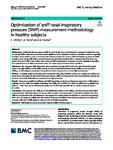Optimization of sniff nasal inspiratory pressure (SNIP) measurement methodology in healthy subjects.
| dc.contributor.author | Subhan, Mirza | |
| dc.date.accessioned | 2023-02-21T12:15:22Z | |
| dc.date.issued | 2023-02-15 | |
| dc.identifier.issn | 1471-2466 | |
| dc.identifier.issn | 1471-2466 | |
| dc.identifier.other | 66 | |
| dc.identifier.uri | http://hdl.handle.net/10026.1/20484 | |
| dc.description.abstract |
Background Maximal inspiratory pressure (MIP) is currently the most commonly used measure for respiratory muscle strength (RMS) estimation, however, requires significant effort. Falsely low values are therefore common, especially in fatigue-prone subjects, such as neuromuscular disorder patients. In contrast, sniff nasal inspiratory pressure (SNIP) requires a short, sharp sniff; this is a natural manoeuvre, decreasing required effort. Consequently, it has been suggested that use of SNIP could confirm the accuracy of MIP measurements. However, no recent guidelines regarding the optimal method of SNIP measurement exist, and varied approaches have been described. Objectives We compared SNIP values from three conditions, namely with 30, 60 or 90 s time intervals between repeats, the right (SNIPR) and left (SNIPL) nostril, and the contralateral nostril occluded (SNIPO) or non-occluded (SNIPNO). Additionally, we determined the optimal number of repeats for accurate SNIP measurement. Method 52 healthy subjects (23 males) were recruited for this study, of which a subset of 10 subjects (5 males) completed tests comparing the time interval between repeats. SNIP was measured from functional residual capacity via a probe in one nostril, while MIP was measured from residual volume. Results There was no significant difference in SNIP depending on the interval between repeats (P = 0.98); subjects preferred the 30 s. SNIPO was significantly higher than SNIPNO (P < 0.00001) but SNIPL and SNIPR did not significantly differ (P = 0.60). There was an initial learning effect for the first SNIP test; SNIP did not decline during 80 repeats (P = 0.64). Conclusions We conclude that SNIPO is a more reliable RMS indicator than SNIPNO, as there is reduced risk of RMS underestimation. Allowing subjects to choose which nostril to use is appropriate, as this did not significantly affect SNIP, but may increase ease of performance. We suggest that twenty repeats is sufficient to overcome any learning effect and that fatigue is unlikely after this number of repeats. We believe these results are important in aiding the accurate collection of SNIP reference value data in the healthy population. | |
| dc.format.extent | 66- | |
| dc.format.medium | Electronic | |
| dc.language | en | |
| dc.language.iso | en | |
| dc.publisher | BioMed Central | |
| dc.subject | SNIP | |
| dc.subject | Respiratory muscle strength | |
| dc.subject | Reproducibility | |
| dc.subject | Healthy subjects | |
| dc.title | Optimization of sniff nasal inspiratory pressure (SNIP) measurement methodology in healthy subjects. | |
| dc.type | journal-article | |
| dc.type | Journal Article | |
| plymouth.author-url | https://www.webofscience.com/api/gateway?GWVersion=2&SrcApp=PARTNER_APP&SrcAuth=LinksAMR&KeyUT=WOS:000936732900001&DestLinkType=FullRecord&DestApp=ALL_WOS&UsrCustomerID=11bb513d99f797142bcfeffcc58ea008 | |
| plymouth.issue | 1 | |
| plymouth.volume | 23 | |
| plymouth.publication-status | Published online | |
| plymouth.journal | BMC Pulmonary Medicine | |
| dc.identifier.doi | 10.1186/s12890-023-02348-0 | |
| plymouth.organisational-group | /Plymouth | |
| plymouth.organisational-group | /Plymouth/Faculty of Health | |
| plymouth.organisational-group | /Plymouth/Faculty of Health/School of Biomedical Sciences | |
| plymouth.organisational-group | /Plymouth/Users by role | |
| plymouth.organisational-group | /Plymouth/Users by role/Academics | |
| dc.publisher.place | England | |
| dcterms.dateAccepted | 2023-02-01 | |
| dc.rights.embargodate | 2023-2-23 | |
| dc.identifier.eissn | 1471-2466 | |
| dc.rights.embargoperiod | Not known | |
| rioxxterms.versionofrecord | 10.1186/s12890-023-02348-0 | |
| rioxxterms.licenseref.uri | http://www.rioxx.net/licenses/all-rights-reserved | |
| rioxxterms.type | Journal Article/Review |


